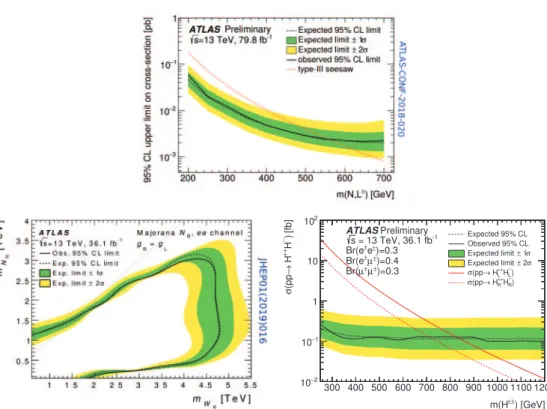DOI 10.1393/ncc/i2020-20069-4 Colloquia: IFAE 2019
IL NUOVO CIMENTO 43 C (2020) 69
Search for exotic particles in multileptonic final states with
the ATLAS detector
G. Carratta(1)(2)
(1) INFN, Sezione di Bologna - Bologna, Italy
(2) Dipartimento di Fisica e Astronomia, Alma Mater Studiorum, Universit`a di Bologna Bologna, Italy
received 8 June 2020
Summary. — The search for exotic particles Beyond the Standard Model (BSM) is a major part of the ATLAS physics program. Due to the low number of Stan-dard Model events in final states with large lepton multiplicity, searches in these final states allow to reject a substantial fraction of background providing a better signal-to-noise ratio. New physics (NP) events are searched for in several processes: production of doubly charged Higgs bosons (H±±) and production of heavy neutral or charged leptons predicted, for instance in mechanisms like Type-III SeeSaw or LRSM models. BSM searches in multileptonic finale states using the pp collision data sample collected in the Run2 by the ATLAS experiment corresponding to 80.0 fb−1 of integrated luminosity at a centre-of-mass energy of 13 TeV are presented. Final states with same-sign leptons (only electrons and muons) are particularly interesting since they are affected by low Standard Model background. Searches are performed in final states which maximize the predicted production cross-section.
1. – Introduction
Multileptonic final states allow to search for Beyond the Standard Model (BSM) par-ticles with large sensitivity thanks to the low number of Standard Model background events. In this article three different searches are presented: Type-III SeeSaw heavy leptons, right-handed heavy neutrino and doubly charged Higgs bosons H++. The
anal-yses have been carried out with data collected by the ATLAS detector corresponding to 80 fb−1, with a center-of-mass energy of 13 TeV.
Depending on the scenario considered, the final state is composed by: 2 leptons, 2 jets (heavy neutrino); 2 leptons, 2 jets and 2 neutrinos (Type-III SeeSaw); two same-sign lepton pairs (H±±). Only light leptons, i.e., electrons and muons, are considered.
2 G. CARRATTA
Fig. 1. – Exclusion limits at 95% CL for (upper) Type-III SeeSaw scenario, (bottom-left) heavy neutrino scenario and (bottom-right) doubly charged Higgs scenario.
2. – Analysis strategy
The goal of the three analyses is to find signal excesses with respect to the SM prediction or, alternatively, to set lower limits on the mass of the searched particles.
In the study of the discriminating variables to improve the signal over background ratio, two kinds of regions are defined: Control Regions (CRs) enriched of background events and used to normalize background contribution, Signal Regions (SRs) enriched of signal events and used to extract the signal strength with a likelihood-based fit.
For Type-III SeeSaw search [1], analysis regions are divided considering flavour and charge. SRs are defined requiring pT for both jets and leptons pairs to be higher than
100 GeV and a missing energy significance larger than 10. Diboson, top and fake lep-tons(1) are the main background for this analysis.
For heavy neutrino search [2], analysis regions are divided considering flavour and charge. SRs (CRs) are defined requiring an invariant mass of the leptons pair higher (lower) than 400 GeV. Events with a Z boson produced in association with jets and with top quarks are the main SM backgrounds for this analysis.
For double charged Higgs search [3], analysis regions are divided considering flavour. SRs are defined requiring no b-jets and no Z boson leptonic decay and leptons pairs with
(1) They are objects originated from in-flight decays of mesons (non-prompt leptons), jets reconstructed as leptons and electron-photon conversions.
SEARCH FOR EXOTIC PARTICLES IN MULTILEPTONIC FINAL STATES ETC. 3
an invariant mass lower than 200 GeV are vetoed. Dibosons and fake leptons are the main background for this analysis.
3. – Results
A likelihood-based fit has been performed to extract the signal strength (the ratio of the measured to predicted cross-section). Since no excess over the SM predictions is found, a limit on the searched particles cross-sections can be derived. Exclusion limits have been set at mass values equal to: 560 GeV for Type-III SeeSaw heavy leptons [1], 2.9 TeV for Majorana heavy neutrino in electron channel and 870 GeV [2] for doubly charged Higgs bosons [3]. Exclusion limits contour plots are reported in fig. 1.
REFERENCES
[1] ATLAS Collaboration, Search for type-III seesaw heavy leptons in proton-proton collisions at√s = 13 TeV with the ATLAS detector, ATLAS-CONF 2018-020.
[2] ATLAS Collaboration, Eur. Phys. J. C, 78 (2018) 199.
[3] ATLAS Collaboration, Search for heavy Majorana or Dirac neutrinos and right-handed W gauge bosons in nal states with two charged leptons and two jets at √s = 13 TeV with the ATLAS detector, ATLAS-CONF 2017-053.
